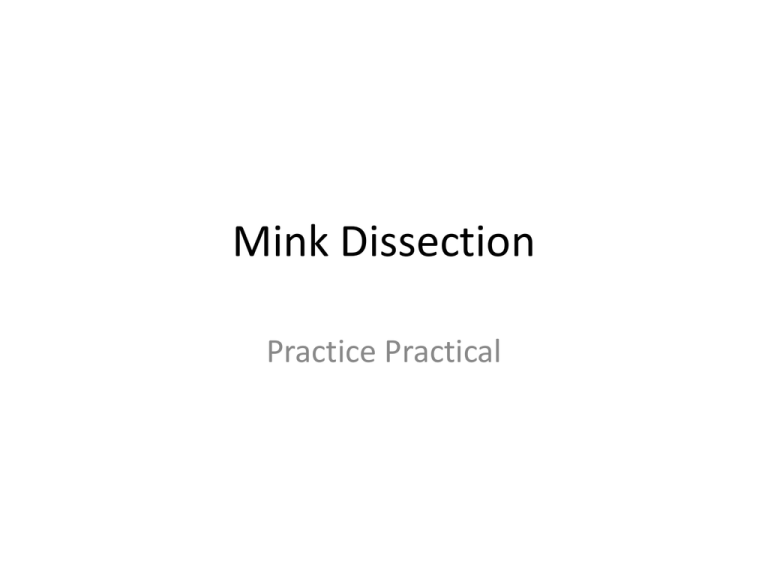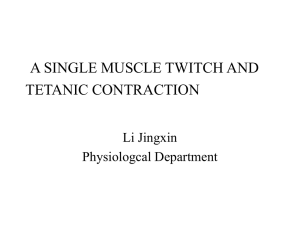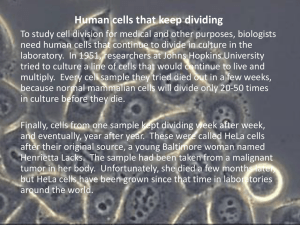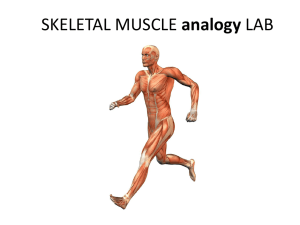Practice Mink Practical
advertisement

Mink Dissection Practice Practical Identify the muscle labeled #1. What is the common name for this muscle? Identify the muscle labeled #1. What is the common name for this muscle? • Rectus femoris • Common Name: Quadriceps; thigh Identify muscle #2. Does this muscle adduct or abduct the thigh? Identify muscle #2. Does this muscle adduct or abduct the thigh? • Gracilis • Adducts the thigh. Identify muscle #3. In humans, this name is slightly different. What is it? Identify muscle #3. In humans, this name is slightly different. What is it? • Sternomastoid • Sternocleidomastoid Identify muscle #4. Identify muscle #4. • Serratus Ventralis Identify this lifted structure #5. What organ system is it part of? Identify this lifted structure #5. What organ system is it part of? • External Jugular Vein • Cardiovascular System Identify this muscle #6. What is its overall function? Identify this muscle #6. What is its overall function? • Masseter • Closes or lifts the jaw This muscle’s origin is the zygomatic process. What bone is its insertion? This muscle’s origin is the zygomatic process. What bone is its insertion? • mandible Identify muscle #7 (lifted on back). Identify muscle #7 (lifted on back). • Latissimus dorsi Identify this muscle #8. What is its function? Identify this muscle #8. What is its function? • Pectoralis major • Adducts forelimbs/arm Identify this muscle #9. In humans, what is the opposing muscle on the anterior side? Identify this muscle #9. In humans, what is the opposing muscle on the anterior side? • Gastrocnemius • Tibialis anterior Identify this lifted structure #10 in the neck region. Identify this lifted structure #10 in the neck region. • Mandibular gland Identify the muscle marked 11. Identify the related structure marked “A” Identify the muscle marked 11. Identify the related structure marked “A” • Clavobrachialis • Brachialis Identify this muscle #12 (ventral side of leg). Another View of #12. Identify this muscle. Identify this muscle #12. • Vastus medialis Identify this muscle #13 (lifted). Identify this muscle #13. (lifted) What bone is its insertion? Close-up of 13 Identify this muscle #13. (lifted) What bone is its insertion? • Acromiotrapezius • Scapula Identify this muscle #14. (lifted) What is its function? Close up of 14 Identify this muscle #14. (lifted) What is its function? • Spinotrapezius • Rotates scapula back or abducts forelimb Identify this muscle #15. What is the common name for this muscle in a human? Identify this muscle #15. What is the common name for this muscle in a human? • Biceps femoris • hamstring Identify this muscle #16. What muscle lies deep and inferior to it? What is the function of both? Identify this muscle #16. What muscle lies deep and inferior to it? What is the function of both? • Tensor fascia lata(e) • Vastus lateralis is deep and inferior • They extends or abducts hind-limb or leg Identify this muscle #17. Identify this muscle #17. • Pectoralis minor Identify this muscle #18 of the neck. (Extra Credit) Close-Up of 18 Identify this muscle #18 of the neck. (Extra Credit) • splenius Identify this muscle #19. (Extra Credit) Identify this muscle #19. (Extra Credit) • Atlantoscapularis What is the muscle labeled “B”? (found ventral to the acromiotrapezium and extends deep into the clavotrapezius) What is the muscle labeled “B”? (found ventral to the acromiotrapezium and extends deep into the clavotrapezius) • Levator scapula(e) Identify this muscle #20. Identify this muscle #20. • Vastus lateralis Identify this muscle #21. How is the position or location of this muscle different in a human? Identify this muscle #21. How is the position or location of this muscle different in a human? • Temporalis • Found laterally on the sides of the skull in a human Identify this muscle #22. (Can also be found from the lateral view) What is the function of this muscle? Identify this muscle #22. What is the function of this muscle? • Semitendinosus • Extends thigh, flexes hind-limb, abducts leg Identify this muscle #23. How is the relative size of this muscle different in humans? Identify this muscle #23. How is the relative size of this muscle different in humans? • Sartorius • Thin in a human (this muscle does not cover the entire ventral surface of the leg as in mink, but wraps laterally from the hip and moves medially towards the knee) Identify this muscle #24. Identify this muscle #25. Identify this muscle #24. Identify this muscle #25. • #24 – adductor longus • #25 – adductor femoris Identify this muscle #26. If you were to reflect this muscle in humans and look at the deeper abdominal muscle, which abdominal muscle would you find moving laterally? Identify this muscle #26. If you were to reflect this muscle in humans and look at the deeper abdominal muscle, which abdominal muscle would you find moving laterally? • External abdominal oblique • Transverse abdominus Identify this muscle #27. Identify this muscle #27. • Triceps longhead brachii Identify t his muscle #28. Identify t his muscle #28. • semitendinosus Identify this muscle #29. (Extra Credit) Identify this muscle #29. (Extra Credit) • Rhomboideus cervicis Identify this muscle #30. Identify this muscle #30. • semimembranosus Identify this muscle #31. What is its function? Identify this muscle #31. What is its function? • Pectineus • Flexes hip and adducts thigh, femur, or leg Identify this muscle #32. In humans, what related muscle lies directly superior to this muscle? What common function do they both have? Identify this muscle #32. In humans, what related muscle lies directly superior to this muscle? What common function do they both have? • Gluteus maximus • Gluteus medius • Extends or abducts leg or femur Identify this muscle #33. What is its function? How many heads does this muscle group have? In humans, what is the opposing muscle? Identify this muscle #33. What is its function? How many heads does this muscle group have? In humans, what is the opposing muscle? • • • • Triceps brachii lateral head Extends forearm, elbow Three Biceps brachii Identify this muscle #34. What is its function? Identify this muscle #34. What is its function? • Spinodeltoid • Pulls humerus or abducts humerus Identify this muscle #35. What is its function? Close-up of #35 Identify this muscle #35. What is its function? • Dorsoepitrochlearis • Extends forearm Identify this muscle #36. What is its function? Close-up of #36. Identify this muscle #36. What is its function? • Levator scapula(e) • Depresses scapula Although not on your mink list, you studies this muscle in a human. Identify muscle #37. Although not on your mink list, you studies this muscle in a human. Identify muscle #37. • Rectus abdominus Identify this deep, cartilaginous structure in the neck #38. What organ system is this part of? Identify this deep, cartilaginous structure in the neck #38. What organ system is this part of? • Trachea • Respiratory system Identify this muscle #39. What is its function? Based on its name, what is the bone of insertion? Identify this muscle #39. What is its function? Based on its name, what is the bone of insertion? • Clavotrapezius • Pulls humerus forward or abducts the arm • Clavicle Identify this number #40. What is its function? Based on its name, what is the bone of insertion? Identify this number #40. What is its function? Based on its name, what is the bone of insertion? • Caudofemoralis • Abducts and extends the leg • femur Identify this muscle #41. (Extra Credit) Identify this muscle #41. (Extra Credit) • Rhomboideus capitis








